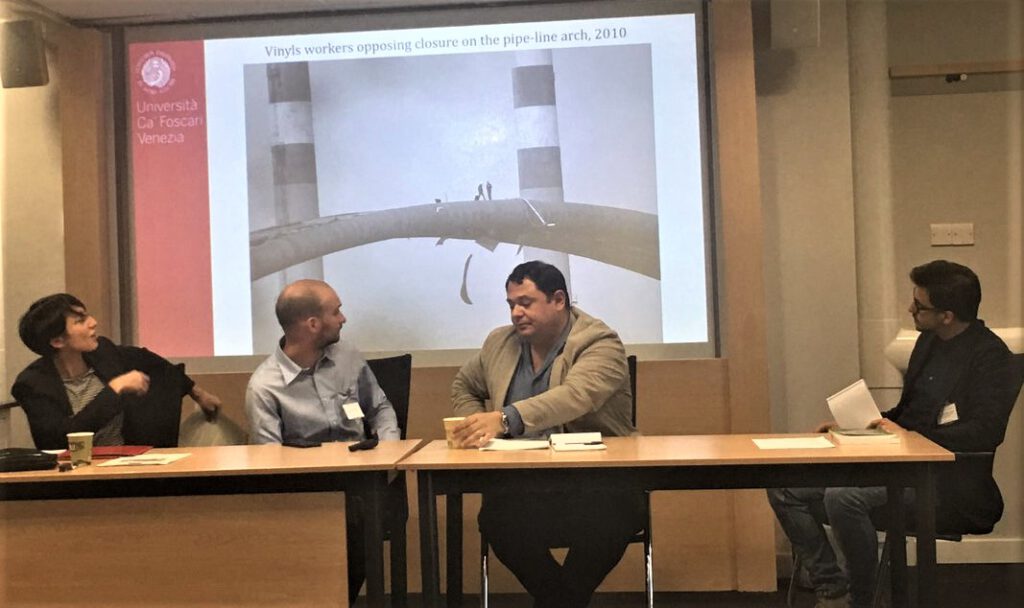David Brown, University of Warwick
On May 30th and 31st, the fourth annual Toxic Expertise workshop took place at the Arden Conference Centre, University of Warwick. The two-day event involved contributions from 20 scholars from multiple disciplines, backgrounds and perspectives. Entitled ‘Interdisciplinary Perspectives on Petrochemical, Fossil Fuel, and related Industries’, the workshop brought together scholars working on cutting-edge research across the downstream, midstream and upstream sectors of the petrochemical industry and across different geographic regions. This year’s Toxic Expertise workshop explored interdisciplinary research on the petrochemical industry through three core themes: Labour Mobilisation, Risk Perception and Environmental Justice.
The first day of the workshop began with the Labour Mobilisation panel, which discussed theoretical frameworks and empirical case studies dealing with the role of workers and labour activism in environmental conflicts over toxic pollution in the spheres of both economic production and social reproduction. Convened by Lorenzo Feltrin (University of Warwick), the panel featured research on labour and the petrochemical industry in an Italian context. Through empirical work in Porto Maghera, Venice and in Gela, Sicily, the contributors to this panel addressed a range of themes including working-class environmentalism, the relations between labour activism and environmentalist movements, critical expertise, and demands over health within and without the workplace.
Firstly, Gilda Zazzara (Università Ca’ Foscari Venezia), a historian, explored the growth of working-class environmentalism among chemical workers at Porto Maghera, the industrial complex and commercial port of Venice which was established in 1917. Drawing on Stefania Barca’s concept of ‘working-class environmentalism’, Gilda evaluated the evolution of labour activism at Porto Maghera from the 1970s until today. In a context in which the petrochemical complex has become synonymous with diseases and death, Gilda highlighted how the labour movements and environmental movements have bifurcated in Porto Maghera in recent decades, and, with workers increasingly threatened by closure of the factory, protests over environmental health have reduced.
Riccardo Emilio Chesta (Scuola Normale Superiore di Pisa a Fierenza) also focused on working-class environmentalism at the Porto Maghera petrochemical site but from a sociological perspective. Riccardo drew out the historical cross-fertilisation of working class movements and environmental activism in Porto Maghera from the 1960s to the 1990s, providing an account of the co-evolution of critical expertise and cycles of contention. Using the example of Gabriele Bortolozzo, a worker at the Montedison petrochemical plant and working-class activist, who provided medical evidence to the public prosecutor in the 1990s of workers’ deaths from exposure to carcinogenic toxins, Riccardo argues that we should take workers’ knowledge seriously as not only lay expertise but as ‘professional expertise’.
Following this, Pietro Saitta (University of Messina) presented on a divergent case of the petrochemical industry and working-class activism in Italy, through examining the petrochemical complex in Gela, Sicily. While in the North of Italy, the working-class was unionised and conflictive in an active economic milieu, in the South, with few alternative forms of employment, there was a distinct lack of resistance or industrial struggles in the petrochemical industry, what Pietro referred to as the ‘ideal, depoliticised subjected worker’. Health and environmental questions did not appear in Gela, a space which can be considered as a ‘sacrifice zone’. Interestingly, Pietro highlighted that where there were struggles in relation to the petrochemical industry in Gela, these tended to be for companies’ continued investment in the region, rather than for labour rights or conditions, or, as protestors stated in response to toxic hazards in the area: “better sick than unemployed”.
The labour mobilisation panel engendered an enlivening debate around the contested nature and extent of working-class environmentalism and whether working-class environmentalism can interact with or encompass other movements, such as those led by students. On the one hand, working-class environmentalism refers to the labour conditions of factory workers, encompassing environmental and health conditions. On the other hand, if we are to use Stefania Barca’s definition of working-class environmentalism, the concept should be extended to encompass the social reproduction of the community, as well as the conditions of production. Such discussions reflected an interrogation of the classic employment-environment dilemma and the idea of the ‘jobs blackmail’ in a context of deindustrialisation and reduced employment levels in the petrochemical sector. The panel discussions also touched upon the role of labour in transitioning to a low-carbon economy, notably if a working-class environmental movement could ever advocate the closure of the factory.

Following lunch, the Risk Perception panel took place, exploring a variety of industrial and environmental hazards and the perceptions of the public towards these. The panel was divided evenly into two sessions. Convened by Thomas Verbeek (University of Warwick), the first session focused on a broad assessment and examination of risk and risk perception of a variety of industrial, environmental and technological hazards, characteristic to our modern society. From both quantitative and qualitative perspectives, these seek to understand how we can we assess and understand risk and the public’s perception of risk. Meanwhile, the second session, convened by Calvin Jephcote (University of Warwick), presented a series of geographic case studies of public risk perception of petrochemical facilities in Spain, Belgium and China. These involved the empirical examinations of the role of established relationships between firms and local communities, the trade-off between environmental risk and economic benefits and the mechanism of ignoring and ‘unnoticing’ environmental risk in certain circumstances.
In the first contribution, Calvin Jephcote presented a traditional quantitative analysis of risk for fenceline communities exposed to toxic pollution. Calvin conducted a systematic review and meta-analysis of epidemiological studies investigating the association between incidences of haematological malignancies and residential exposure to the petrochemical industry. Across 16 unique studies, which cover a period of analysis between 1960 and 2011, the meta-analysis found that residents living no more than 5km from a petrochemical facility had a 30% higher risk of developing leukaemia than residents from communities with no proximal activity from the petrochemical sector.
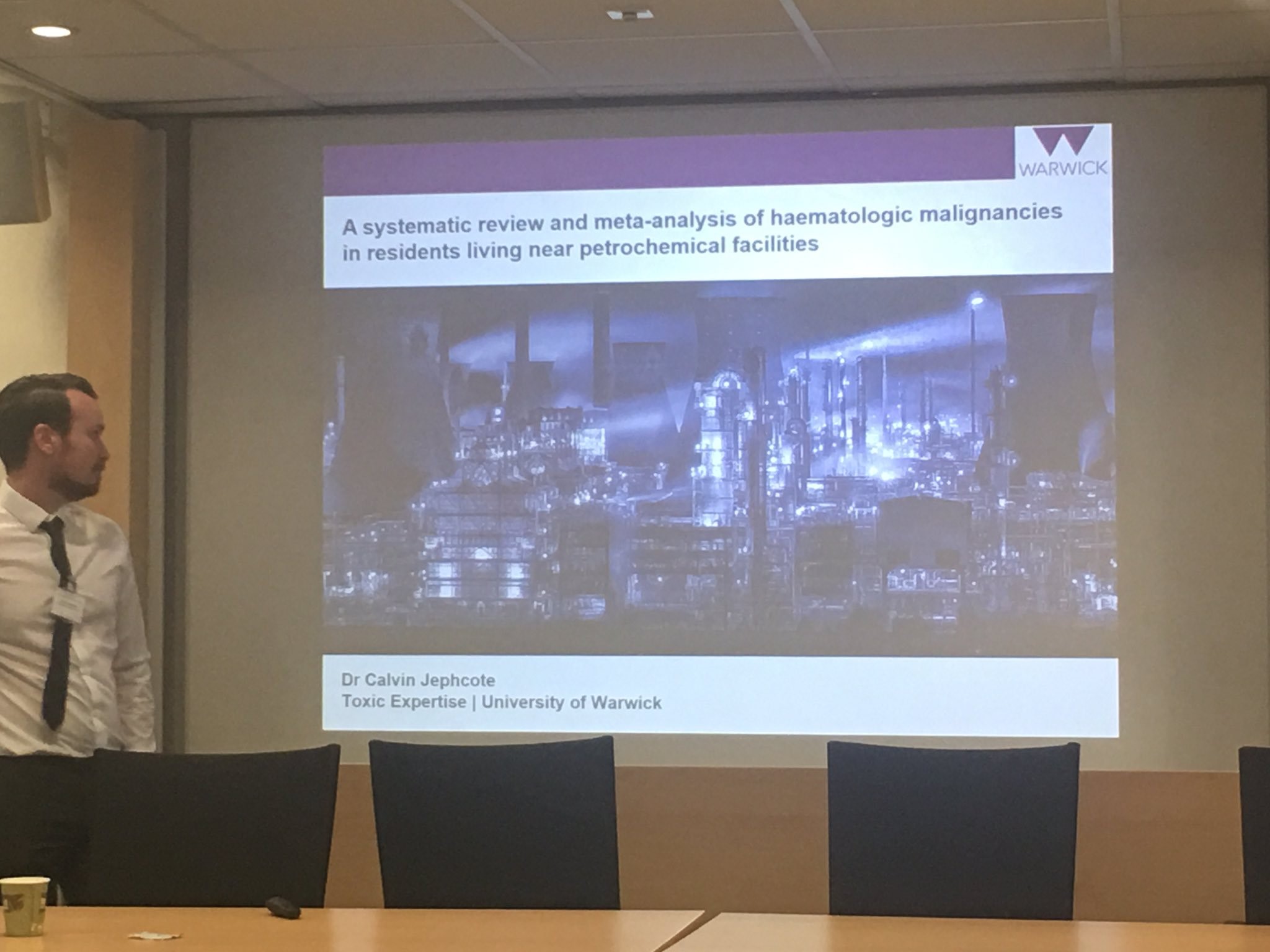
The following two presentations looked at the multi-dimensional factors which impact upon the public’s perceptions of risks associated with environmental and technological hazards. Vivianne Visschers (University of Applied Sciences and Arts Northwestern Switzerland) discussed how the public perceives environmental and technological hazards and what determines their acceptance of these. Vivianne demonstrated the relationship between the public acceptance of environmental and technological hazards and three primary factors: trust in stakeholders, affective associations and perceived benefits of the hazard. She also discussed how trust is an underlying factor in the public’s perception of the risks and benefits of industry and is closely connected to the production of knowledge by key stakeholders.
Next, Matthew Cotton (University of York) specifically focused on the ‘language of risk’ and the deployment of linguistic devices through which the public and media perceives, frames and communicates risk. Notably, Matthew explored the use of humour among those living with nuclear power in the UK (at Oldbury and Bradwell), demonstrating how examining the use of humour can lead to richer understandings of the lived experiences of risk. In this case, the residents’ jokes are understood to be coping mechanisms, and to both mask and reveal affectively-charged states. Matthew also highlighted his other research which examined metaphors of unconventional hydrocarbon development in mainstream newspapers in the US, UK and Australia through frequency analysis and type hierarchy analysis.
Opening the second session, Loretta Lou (University of Macau / London School of Economics) explored why residents of two villages in close proximity to a petrochemical plant in Guangzhou, China appeared to be apathetic about the dangers of toxic pollution and the risk of accidents. Drawing on ethnographic fieldwork, Loretta used the concept of ‘unnoticing’ to help explain the contrived ignorance of the residents and their passivity towards environmental risks and injustices. In coping with everyday toxicity, people in these villages had become indifferent to, or accustomed to, the nearby petrochemical pollution. There were analytical linkages between Loretta’s research and Matthew’s research on the use of humour in thinking about the ways in which fenceline communities learn to cope with, or co-exist with, attritional, everyday toxic pollution.
The following two presentations explored risk perception of fenceline communities and firm-community relations in petrochemical clusters in a European context. Miguel Ángel López Navarro (Universitat Jaume I) presented research on firm-community relationships in Spain across two petrochemical clusters. He analysed how local communities differentially perceive the benefits and risk of industry, despite the pollution levels being similar. Miguel identified three key factors associated with firms’ behaviour that contribute to explaining differences in local community perceptions: commitment to building stronger socio-economic links with the community, efforts to engage the community through a dialogue process and the articulation of a collective strategy through local intermediary institutions.
Subsequently, Thomas Verbeek explored the trade-offs between environmental risk and economic affluence for residents living close to the Antwerp petrochemical complex, Europe’s largest petrochemical cluster, through a socio-cultural approach. Thomas investigated how residents of two fenceline communities in Antwerp (with different profiles) deal with risk in their everyday lives and how they balance industrial risk against economic benefits, in a context in which local residents appear to be accepting of the industry. His findings suggest that the most important factor to explain acceptance is the perceived socio-economic benefit for the community.
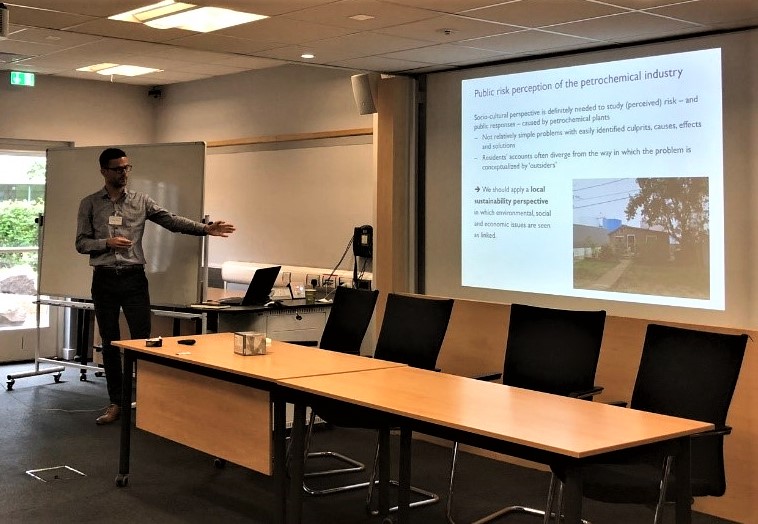
The Risk Perception panel highlighted the multi-dimensional factors which can influence how a community perceives the risk from an environmental or technological hazard and what determines acceptance of the risk. Many of these contributions demonstrated the importance of exploring risk perception at the community level and socio-cultural factors. The prominence of factors such as trust (in authorities, companies) or perceptions of benefits is determined by the social, cultural, economic or political profiles of communities. Interestingly, at least three of the contributions in the panel explored ways in which residents of fenceline communities learn to cope with the everyday risks of toxic pollution or hazards, or at least, the ways in which these are traded off for the socio-economic benefits of the industry. Wider research suggests that public risk acceptance is a balancing act and if one underlying factor is to change, environmental or technological hazards in these communities may be brought to the surface or rendered visible.
The second day of the workshop opened with the environmental justice panel. Convened by David Brown (University of Warwick), the panel explored a range of environmental justice issues associated with the petrochemical, fossil fuel and related industries. Across varied scales, themes and geographic contexts, research in this panel provided insights into the environmental challenges, conflicts and impacts connected to these industries through a justice lens. Contributors to this panel discussed and reflected upon environmental justice concerns across the downstream, midstream and upstream sectors of the petrochemical sectors, encompassing issues connected to toxic pollution, plastic waste, oil extraction, environmental participation and a just energy and climate transition.
In the first contribution, Thom Davies (University of Nottingham) presented his ethnographic research on fenceline communities of Cancer Alley, Louisiana, the largest concentration of petrochemical industries in the Western world. Thom emphasised the importance of time when researching the long-term experience of living with pollution. Through the concept of ‘slow observation’, Thom contests Nixon’s (2011) framing of ‘slow violence’ as a necessarily invisible form of brutality. His research revealed the myriad ways in which marginalised communities in Cancer Alley have observed forms of environmental degradation or violence over decades of living with toxicity. As forms of ‘temporal noticing’, Thom’s theorised ‘slow observations’ can be put into conversation with Loretta’s concept of ‘unnoticing’ in Guangzhou, whereby longevity was used by residents to highlight how they were surviving regardless of pollution.
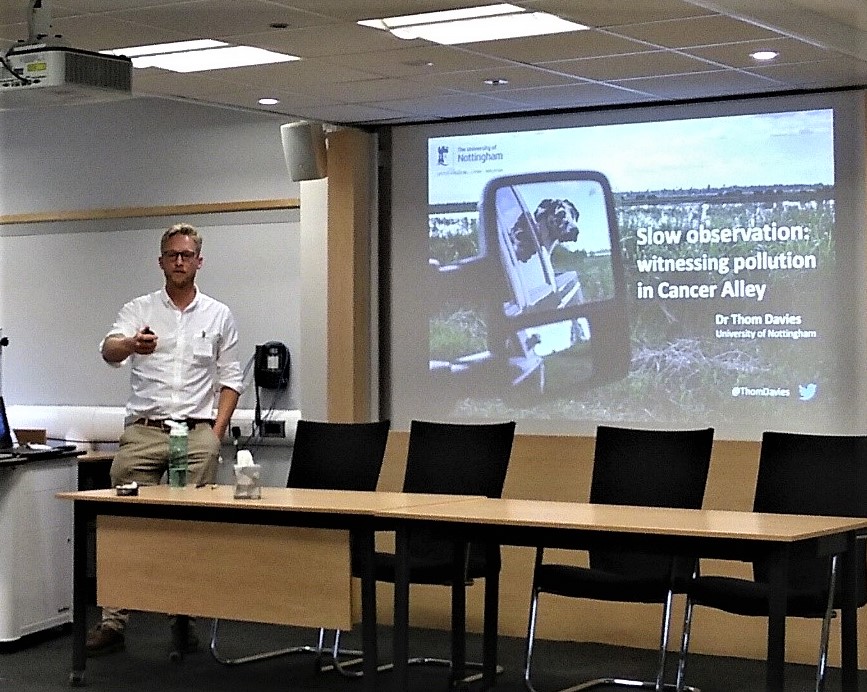
Next, Dianne Sicotte (Drexel University) traced the strand of the ethane-to-plastics global production network and drew out the environmental injustices- understood as threats to health, safety and human rights- at each node of the production network. From the fracking of natural gas in Pennsylvania to the transport infrastructure connected to ethane production and shipping (e.g. pipelines, tankers) to the industrial production of petrochemicals and the dumping of plastic waste, Dianne highlighted how the ethane-to-plastics global production network produces environmental sacrifice zones at downstream, midstream and upstream sectors. Dianne drew out fascinating linkages between these multiple forms of environmental injustices and the overproduction which characterised both the gas boom and ethane boom, and connected infrastructural developments.
Subsequently, Adrian Gonzalez (University of York) explored the multifaceted natural resource extraction injustices facing rural Peruvian communities in the Loreto region of the Amazon. Through the political ecology of voice (PEV) theoretical framework, Adrian uncovered a number of injustices related to oil extraction in this context. Relations between the oil companies and the communities are built on exploitation and abuse, notably through the ‘jobs for silence’ discourse. In a context in which the state is aggressively pursuing a hydrocarbon and development vision and social protests are routinely criminalised, Adrian highlighted the absence of meaningful participation for rural communities in Peru, compounded for marginalised citizens (indigenous groups, ethnic minorities), fuelling radical voice action and participatory explosions for citizens seeking access to and recognition of environmental issues.
After the break, Richard Balme’s (Sciences Po, Paris) presented on environmental justice in China and reflected on the concept of environmental authoritarianism. Driven by the development of legislation and litigation, Richard suggested that there has been significant progress in environmental policy-making in China over the last two decades. However, while the party leadership in China is committed to environmental policy-making and recognises a number of internationally-accepted environmental rights, the implementation of the law is often partial or insufficient. Nevertheless, Richard proposed that today there is a more open policy process and enhanced participation in China, highlighting evidence of protests achieving positive outcomes.
The final presentation of the panel came from John Barry (Queens University Belfast) who critically reflected on the concept of a ‘just transition’. Originating in the US labour movements in the 1980s, a just transition framing puts justice, democracy and human rights at its centre in response to climate breakdown and the low-carbon energy transition. While an energy transition is inevitable, a just one is not. In identifying the intimate connections between cheap and abundant carbon energy and the capitalist growth imperative, John subsequently asked if a post-carbon society is also a post-capitalist one. Accordingly, John proposed that a just transition is not the greening of ‘business-as-usual’, but instead represents and equitable end to the fossil-fuel age with decent and well-paid jobs (i.e. ‘system change, not climate change’).
In the last session of the workshop, The ‘Global Petrochemical Map’ was showcased by Alice Mah (University of Warwick). As we highlight in greater detail elsewhere, the Global Petrochemical Map is an international, interactive and collaborative public resource which maps cases around the globe of major petrochemical sites, local communities, community and labour mobilisations, and details of emissions, environmental and safety records, photos, and media reports. Alice provided a background and rationale for the project and demonstrated some of the mapping tool functionality, following which David Brown and Lorenzo Feltrin showcased some of the work done so far on the Map and a few of the prominent cases which have been added to the public resource.
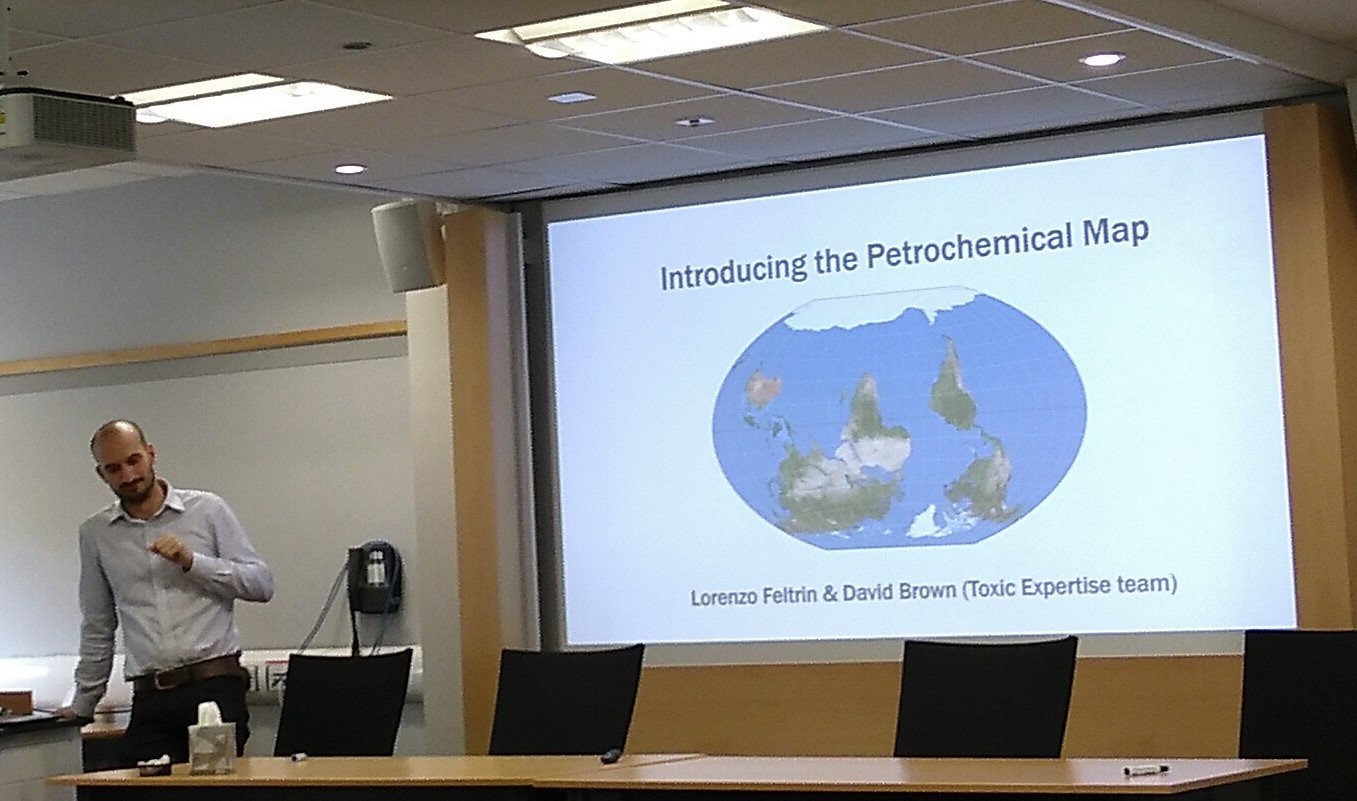
Workshop participants were invited to contribute to the Map in whatever way they could and were asked for their feedback on the mapping tool. A Q&A session followed in which discussions were centred around the challenges in reaching communities which do not have access to the internet or do not speak English, the difficulties faced in compiling cases in which there is less data or information available through online resources (e.g. China, Middle East), and the possibilities of including a maritime or infrastructural element on the map, to incorporate logging of plastic waste, shipping and pipelines. The annual workshop concluded with a roundtable discussion in which each participant reflected upon what they had taken from the workshop, the themes of the workshop, and what research ideas they had going forward.
Across the diverse, interdisciplinary research showcased at the workshop, a number of analytical and thematic connections can be made. Through varied perspectives, approaches and geographic case studies, workshop participants grappled with complex and engaging themes such as the multiple environmental injustices occurring across different nodes or sectors of the petrochemical industry, the tensions between economic prosperity and environmental degradation for fenceline communities, the (in)visibility of pollution for residents in divergent socio-political, economic and cultural contexts, the challenges in achieving synergies between labour activism and environmentalist movements, and envisioning what a just low-carbon or post-carbon transition may look like. The range of research at the workshop drew out environmental crises, injustices and risks across the downstream, midstream and upstream sectors of the petrochemical industry, notably incorporating oil exploration and extraction, natural gas fracking and petrochemical and plastics production.
While labour mobilisation, risk perception and environmental justice, as research perspectives and core themes, each offer specific contributions to expanding our understanding of the petrochemical, fossil fuel, and related industries and its impacts upon, and relations with, fenceline communities and workforces around the world, close connections can also be made between these. Notably, in drawing out both labour and environmental injustices, we can begin to interrogate dualistic framings of employment and environment connected to the petrochemical industry and the concept of the ‘jobs blackmail’. Risk and risk perception are also intimately connected to both labour mobilisation and environmental justice. The array of research at the workshop highlighted the health and environmental risks borne by fenceline communities exposed to toxic and hazardous pollution in their everyday existence. Through risk perception analysis, we can better understood how affected communities themselves perceive the environmental or technological hazards which environmental justice research would typically highlight to be unevenly distributed or unjust.
